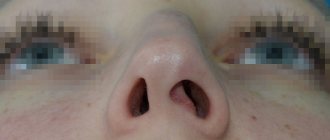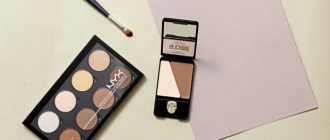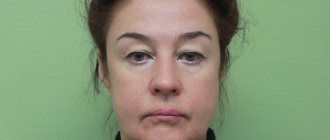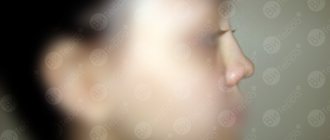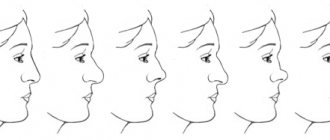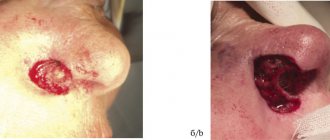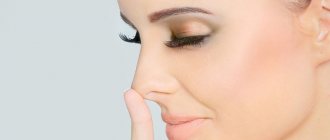The ideal nose is one that occupies one third of the face. The width of the nose should not be greater than the longitudinal section of the eyes, and the wings of the nose cannot extend beyond the lines drawn down the inner corners of the eyes.
If you want to see how a new nose shape will look on your face, then try Face Warp Plastic Surgery, Plastic Surgery Simulator Lite.
But you should still start not from mathematical calculations, but from the option that you initially have. With minimal correction you can get a harmonious face.
Greek nose
Natalie Portman, Sakis Rouvas
The most desirable shape not only among girls, but also among men, which meets all standards, can be called the Greek nose. An elongated graceful bridge of the nose, a refined tip and small nostrils are its distinctive features.
This nose suits almost everyone without exception. If you are the owner of a Greek profile, then we can only be happy for you, because in most cases this form is not required to be corrected.
The classic form was a continuation of a straight line from the forehead to the tip of the nose without marking the bridge of the nose or with a slight indentation. Of course, now this form is quite rare, and if it does occur, then its owner is most often dissatisfied with the bridge of the nose. This area can be made more expressive using contouring.
Researchers' opinion on facial proportions
If you have already drawn your ideal nose in your mind according to the parameters you have studied, take your time. Nose parameters are not beauty. It is impossible to build it following the common dimensions of angles and centimeters. Such a nose should correspond to the golden ratio. To make your face look harmonious, it is important to consider the size of its individual parts. Therefore, for a large face, a nose larger than the generally accepted sizes of researchers is suitable. If your face is small, your nose should be smaller. A slightly upturned nose suits short women, but tall women do not need this at all - people will pay attention to their nostrils.
According to the generally accepted opinion of researchers, the following characteristics include the ideal facial proportions:
- the widest part of the face in the ratio of length and width should have approximate parameters in the region of 1.61 (in accordance with the rule of the “golden ratio”). These sizes were considered ideal back in antiquity. This concept became more widespread during the time of Leonardo da Vinci, being used in painting and architecture;
- The width of the face at eye level should correspond to the length of the eye from the outer to the inner corner multiplied by 5. And the size of the bridge of the nose should be equal to the length of the eye. The area of the face between the outer tip of the eye and the ear should also be equal to the length of the eye;
- the eyes should be on a horizontal line dividing the head in half (from the bottom of the chin to the top of the head);
- the area of the forehead from the roots of the hair to the eyebrows should correspond to the distance from the line of the nose to the chin;
- the width of the nose should be equal to the distance between the inner corners of the eyes;
- the width of the mouth should correspond to the width from one iris to the other;
- an equilateral triangle should form between the outer corners of the eyes and the midpoint of the lower lip;
- the beginning of each eyebrow should begin on a vertical line at the level of the inner corner of the eye;
- The height of the chin should correspond to the length of the eye.
These are the generally accepted proportions of the correct facial structure. Without exaggeration, we can say that each of us is concerned about how he looks. However, the exact natural coincidence of all parameters is quite rare. But this does not mean that people with non-standard facial features are ugly. Despite the fact that in our time a person’s attractive appearance is perceived as a sign of his health, when choosing a public profession, not only generally accepted proportions are taken into account, but also the internal qualities of a person. Sometimes a charismatic but ugly person is a famous actor, while a hard worker with regular facial features works as a painter at a construction site.
Roman nose
Sofia Coppola, Tom Cruise
The Roman shape attracts attention. Such a nose can be straight, with a curved back or even with a hump, with large or small nostrils. The main distinguishing feature is the downward sloping tip.
The Roman nose looks most advantageous on a man's face and, in rare cases, on a woman's face. The first step is to correct defects such as humps. If your nose is straight, then there is no need to change it, because you have a noble profile.
NOSE SHAPE AND HUMAN CHARACTER
Straight nose shape
This is a clear indication of honesty, openness, energy, and even character. But if the owner of a straight nose has personal or professional achievements, he can become arrogant and vain.
Nose shape: narrow and long
This is the nose of a thinker. Its owner most often has a developed intellect, but is prone to whims and is prone to conservatism. It is especially difficult for him in matters of love - decisions are made with great difficulty. And this leads to the formation of fatal love triangles, and such relationships can last a very long time.
Nose shape: fleshy, wide and long
His owner was lucky: a calm character, stable temperament, thriftiness, an abyss of charm and sexuality that representatives of the opposite sex cannot resist. His views on the world are simple to the point of primitiveness, and he is ready to defend his existing misconceptions always and everywhere, showing enviable tenacity. If a flat and wide nose is complemented by protruding lips and a heavy chin, this indicates peremptory judgment and unwillingness to take into account the opinions of others. Such people are real dictators.
Nose shape: aquiline
People who are lucky enough to have an aquiline nose are cunning, practical, have business acumen and tireless sexuality. They are destined for wealth and great success. If this nose shape also has a downward-curved tip, its owner thinks through every step in advance and has little trust in people. Thanks to such character qualities, he never falls into scams, but success accompanies, with rare exceptions, all of his commercial enterprises. A small hump on an aquiline nose speaks of the determination, aggressiveness, stubbornness and pride of its owner.
Nose shape: short
A short nose makes the face look youthful and pretty, and also indicates the docile nature, cheerfulness, sociability and optimism of its owner. There is no chance for such people to have a career, but they will have no problem finding a spouse who will be successful in life. The owner of such a nose is most often unable to keep secrets, neither his own nor those of others. It is difficult for him to comply with the requirements of etiquette and moral principles, and he prefers to consider himself “free from conventions.” This does not make his life easier, but it will never be monotonous and boring. She will be filled with adventures, including love ones.
Nose shape: short high nose
Very characteristic nose shape. It is sharply chopped off and forms the so-called “lion profile” and endows its owner with “lion” character traits - pride, rebellion, pathological perseverance. They help him withstand any adversity in life.
Nose shape: snub nose
A clear indication of great kindness and even a penchant for self-sacrifice. Most of these people have overflowing energy, a more developed imagination than others, plus high self-esteem and a penchant for adventure. As a result, with enviable regularity they get involved in adventures, mostly dubious, plunging into them headlong. Their love relationships are built on the same principle. But the ability to attract money from a snub nose is simply amazing!
Nose shape: potato
Its owner is slow, phlegmatic, does not tolerate any gossip, squabbles, or deception. He has a fairly harmonious character, but tends to make decisions without thinking through their consequences well.
Upturned nose
Elizaveta Boyarskaya, Matt Damon
A distinct bridge of the nose and an upturned tip of the nose are considered endearing features. But this form is not suitable for everyone.
First of all, this nose shape is corrected by men, making it more straight to give masculinity. This is due to the fact that many people associate an upturned nose with an open, soft and more feminine character.
Girls in this case should not worry. Scientists have found that the ideal nose angle is 106 degrees. This angle is measured between a line that is parallel to the bridge of the nose and a line connecting the tip of the nose to the upper lip. As a rule, an upturned nose always fits into this standard.
Anatomical structure
An ideal nose (the structure of the respiratory organ is given below in the article) should not only be responsible for the air exchange of the human body, but also correspond to modern canons of beauty, which require a symmetrical arrangement of all parts of the face.
The human nose is unique, participates in the formation of speech, allows us to distinguish smells and supports the immune system. The structure and shape of the nose can vary significantly depending on the age, gender, race and individual characteristics of a person.
Residents of Eastern and Western Europe are characterized by a narrow and high sense of smell. African Americans and people living in Australia, Asia and Malaysia have a more voluminous nose with wide wings.
The anatomical structure of the nose consists of:
- nasal cavity;
- outdoor area;
- paranasal sinuses, connected by thin canals.
Main functions of the nose:
- Respiratory, helping to provide the body with the level of oxygen necessary for its full functioning.
- Thermoregulatory, which consists in heating the cold air entering the human body due to the transfer of heat from numerous blood vessels.
- Moisturizing, saturating the dry air flow with the secretion of the epithelium.
- Protective, designed with the help of small hairs to retain pathogenic microorganisms entering with the air.
- Resonator, which consists in the participation of the respiratory organ in the formation of speech, creating resonance of the voice and giving it individual characteristics.
- Olfactory, recognizing odors using olfactory cells.
The outer part of the nose has the shape of an irregular triangular pyramid, created by soft, cartilage and bone tissues.
In its anatomical structure, the nose occupies the central part between the oral cavity, eye sockets and cranial fossa. The anterior part extends to the surface of the face through the nostrils, and the posterior part to the pharyngeal region through the choanae.
The bony section (dorsum of the nose) has paired nasal bones connected to the nasal processes of the frontal bone and the laterally adjacent frontal processes of the upper jaw.
This part is a fixed bone skeleton to which a cartilaginous section is attached, composed of:
| Paired lateral cartilage | It has a triangular shape and takes part in the creation of the wings and back of the nose. The posterior edge of the cartilage is adjacent to the beginning of the nasal bone, and with the help of the middle edge it fuses with the cartilage located on the opposite side. Its lower edge is attached to the nasal septum. |
| Paired large cartilage | Surrounding the entrance to the nostrils and divided into:
All cartilages are connected to each other by bone and fibrous tissue, and then covered by periosteum. |
External part
The external nose is covered with skin tissue, on the surface of which there are a large number of sebaceous glands, hairs and nerve endings. The wings contain facial muscles that allow them to be compressed or unclenched, raising or lowering the tip.
Under the bones are located:
- upper lateral cartilage - in the lower part of the nasal dorsum;
- large alar cartilages - in the wings of the nose;
- lower lateral cartilage - at the tip of the nose;
- additional cartilage - along the outer wings.
The nasal cavity is surrounded by:
- pride muscle (on the forehead and bridge of the nose);
- the muscle that lifts the upper lip and the wing of the nose (on the sides of the nose in the longitudinal direction);
- nasal muscle - transverse (located in the dorsum of the nose) and alar parts,
- anterior nostril dilator,
- small constrictor of the nostrils,
- muscle that depresses the nasal septum.
Interior
The internal part is represented by the nasal cavity with olfactory elements and conchae, as well as the paranasal sinuses.
Hooked nose
Paris Hilton, Mike Douglas
In this case, the tip of the nose tends to the lips, and when smiling it drops even lower. As a rule, many people seek to correct this shape of the nose with the help of rhinoplasty: they slightly raise the tip of the nose.
Although some men can just change the upturned shape to a sophisticated aquiline, this way there will be no need to add volume, just adjust the shape.
Ways to make your nose perfect
An ideal nose (the structure of Duchess Kate's respiratory organ is considered ideal for women with a European type of appearance) according to classical criteria should have a strictly straight shape, protruding slightly above the surface of the face.
Modern cosmetology and plastic surgery have ample opportunities for correcting the shape of the nose to bring it closer to the ideal standards of the “golden ratio”.
Rhinoplasty
One of the most popular surgical procedures in the world allows you to correct congenital or acquired deformities of the nose, as well as completely restore it if it is missing. With the help of rhinoplasty, you can solve nasal breathing problems, correct the consequences of injuries, or correct your appearance for aesthetic reasons.
The operation allows you to change the shape of the nose and its position without disturbing the basic functions, by adjusting and changing the amount of cartilage tissue.
Rhinoplasty is permissible if:
- hump removal;
- correction of non-standard shape of the tip of the nose;
- desire to lower or raise the tip;
- changing the distance between the upper lip and nose;
- narrowing of the back of the nose;
- changing the size of the nostrils or the nose itself;
- alignment of the respiratory system;
- the need to eliminate a crooked partition or straighten it.
The operation takes place under general anesthesia and takes about 1.5-2 hours. In standard surgical techniques, incisions are made inside the nose, and then using special instruments, the surgeon can move the bones or change the tip or part of the septum.
Upon completion of the operation, the patient will have a 7-10-day recovery period and dressings. 2 Two days after the operation, the nasal vestibule is filled with tampons, and for 6-7 days the patient is forced to wear a plaster cast. Rhinoplasty is performed by most plastic surgery clinics at a cost of 100 thousand rubles.
Modeling with fillers
The use of fillers based on hyaluronic acid is used for non-surgical correction of the back and wings of the nose. Preparations injected under the skin add volume, model the shape and contours, thereby compensating or camouflaging an aesthetic defect. The main component of most fillers is hyaluronic acid.
Preparations based on:
- calcium hydroxyapatite - an organic compound natural to the human body;
- collagen;
- synthetic substances (polycaprolactone, silicone, polylactic acid).
Preparations based on calcium hydroxyapatite are biodegradable and give unstable results that last for up to 6 months. Fillers with silicone fillers give a lasting result, but due to the fact that they are limited from living tissue to a fibrous capsule, over time they can lead to the appearance of pronounced age-related changes.
The use of fillers is indicated for:
- eliminating (hiding) subtle cosmetic defects;
- nose contour correction;
- smoothing the sharp bridge of the nose;
- increasing the volume of the nose;
- masking the hump and depression on the back of the respiratory organ.
A significant drawback of the technique is its inability to radically correct the shape of the nose. It is also not recommended to use fillers in the area of the tip of the nose.
The cost of correction with fillers ranges from 20 to 50 thousand rubles.
Correction with hormonal drugs
The technology, based on correcting the shape of the nose with hormonal drugs, destroys living (mainly) cartilage tissue, thereby removing unnecessary fragments of the nose. After the injections, the doctor manually models the shape of the nose, creating the desired contours, and removes imperfections.
The main problem of the technique is considered to be its danger for the cartilage tissues located near the “problem” areas, since hormones, as low-molecular compounds, easily migrate in the tissues. The second danger of the technique is the degree of severity of its effect. The cost of the method is from 20 thousand rubles.
Changing shape with threads
A thread lift helps correct minor cosmetic defects in the area of the wings and tip of the nose. This procedure can be performed independently or combined with a thread lifting of the entire face. During the procedure, materials that are safe for the human body and compatible with skin tissue in a biological and immune sense are used. The cost of the procedure starts from 10 thousand rubles.
Aligning the contour with a splint
An adjustable splint fixes the wings of the nose from the outer surface, and its two remaining elements are inserted into the nasal passages. The simulator puts pressure on cartilage and soft tissues, thanks to which it allows you to correct surface defects and even reduce the size of the nose. You need to put a corrective splint on your nose 1-2 times a day for 15-20 minutes. The effect of wearing a plastic trainer can be seen after 6-12 months, and the size of the nose will decrease by 2-3 cm.
The disadvantage of this technique is severe discomfort caused by the pressure of the object on the tissue and difficulty breathing.
The cost of the splint is from 280 rubles.
The nose is a prominent part of the human face, responsible for respiratory, olfactory and thermoregulatory functions. An ideal nose, in the modern sense, has a rounded, not very high tip, slightly covering the opening of the nostrils. The classic straight Roman nose is considered the most advantageous shape for men.
For women, according to the rules of the “golden ratio”, a slight elevation of the tip is acceptable, but the most important rule is the ideal straightness of the back, without tilting to the right or left.
